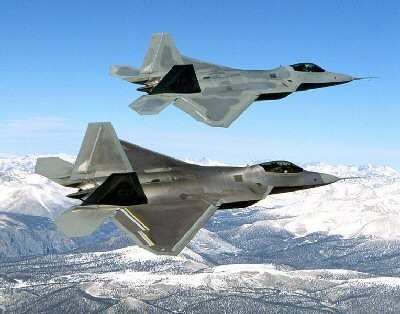Sat, Dec 17, 2011
Mentions Oxygen System Problems, But Cites Pilot Error As The
Cause Of The Accident
The USAF has released its official report on an accident which
occurred November 16th of last year in Alaska in which a
pilot was lost and an F-22 Raptor was destroyed.

In the report, the Air Force says that during the flight At the
fire protection system (FPS) detected a bleed air leak in the
center bleed air ducting from both engines. In response to the FPS,
the Integrated Vehicle Subsystem Controller (IVSC) asserted the C
BLEED HOT caution ICAW while it requested the Environment Control
System (ECS) to isolate the center bleed system. “CAUT”
was displayed in the heads up display (HUD) advising the pilot of
the caution ICAW.
The report seems to indicate that the pilot may have attempted
to start the flow of emergency oxygen to his face mask, but was
unable to do so. "The lack of airflow to the (pilot's) oxygen mask
and the fact that the mask was up and secured in place at the time
of impact suggests the (pilot) would have attempted to activate the
EOS for continued airflow. However, analysis of the EOS from the
wreckage determined it was not activated," the report reads.
The report suggests that the distraction caused by trying to
activate the emergency oxygen system was the primary cause of the
accident. It says the pilot input a combination of right forward
stick and right pedal which initiated a 240 degree descending right
roll at greater than 45 degrees per second. "At the completion of
these stick and pedal inputs (the pilot) had rolled through
inverted, experienced less than 1 g of gravitational force, and
went from a RWD to LWD attitude, and the descent rate of the
aircraft significantly increased.
These control inputs appeared to be inadvertent because:
- They had no clear goal or objective.
- They resulted in an unusual attitude.
- During ground simulation, when the pilot member repositioned
his torso to visually
- acquire the manual EOS activation ring, he inadvertently
actuated the stick and
- pedals.
- The MP (pilot) made no attempt to correct the MA’s
(aircraft's) unusual attitude for 30 seconds after
- completion of these inputs.
"The inadvertent operation of the flight controls placed the
(aircraft) in an unusual attitude which was unnoticed by the MP.
This resulted in the MP’s unrecognized spatial
disorientation.
The report does list several factors it calls "non-contributory"
to the accident, including sudden incapacity or unconsciousness,
efforts of G-Forces, and hypoxia. The report says the evidence does
not support any of those factors as contributing to the
accident.
More News
How To Get A Story On Aero-TV News/Feature Programming How do I submit a story idea or lead to Aero-TV? If you would like to submit a story idea or lead, please contact Jim Campbel>[...]
Aero Linx: International Association of Professional Gyroplane Training (IAPGT) We are an Association of people who fly, build or regulate Gyroplanes, who have a dream of a single >[...]
NORDO (No Radio) Aircraft that cannot or do not communicate by radio when radio communication is required are referred to as “NORDO.”>[...]
Beyond Visual Line Of Sight (BVLOS) The operation of a UAS beyond the visual capability of the flight crew members (i.e., remote pilot in command [RPIC], the person manipulating th>[...]
Aero Linx: Malibu M-Class Owners and Pilots Association (MMOPA) The Piper M-Class Owners & Pilots Association (PMOPA) is a not-for-profit organization dedicated to the interest>[...]
 ANN FAQ: Contributing To Aero-TV
ANN FAQ: Contributing To Aero-TV ANN's Daily Aero-Linx (05.29.24)
ANN's Daily Aero-Linx (05.29.24) ANN's Daily Aero-Term (05.29.24): NORDO (No Radio)
ANN's Daily Aero-Term (05.29.24): NORDO (No Radio) ANN's Daily Aero-Term (05.30.24): Beyond Visual Line Of Sight (BVLOS)
ANN's Daily Aero-Term (05.30.24): Beyond Visual Line Of Sight (BVLOS) ANN's Daily Aero-Linx (05.30.24)
ANN's Daily Aero-Linx (05.30.24)



